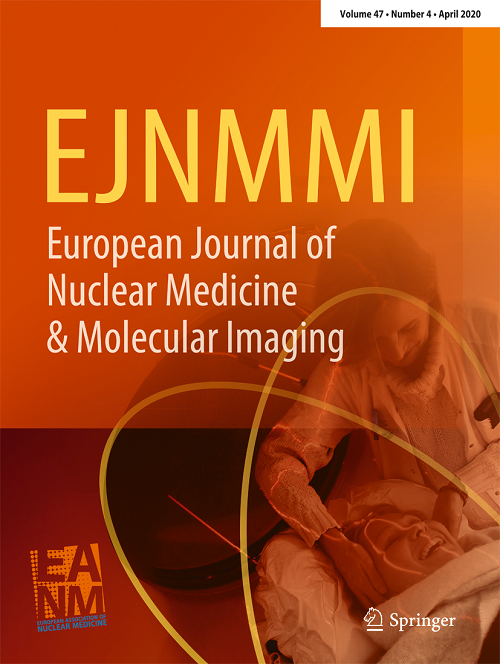ImmunoPET imaging of c-Met using a nanobody-based tracer [68Ga]Ga-NOTA-PFCM01 in pancreatic ductal adenocarcinoma models and non-human primates.
IF 8.6
1区 医学
Q1 RADIOLOGY, NUCLEAR MEDICINE & MEDICAL IMAGING
European Journal of Nuclear Medicine and Molecular Imaging
Pub Date : 2025-07-09
DOI:10.1007/s00259-025-07441-6
引用次数: 0
Abstract
PURPOSE Pancreatic ductal adenocarcinoma (PDAC) is the most prevalent form of pancreatic cancer, with high malignancy and poor prognosis. The cellular mesenchymal-epithelial transition factor (c-Met) is overexpressed in 84% of PDAC and plays a critical role in tumor progression, which is closely associated with poor patient outcomes. In this study, a new 68Ga-labeled nanobody ([68Ga]Ga-NOTA-PFCM01) was developed for the visualization of c-Met in PDAC models. METHODS The Cancer Genome Atlas (TCGA) and the Genotype-Tissue Expression (GTEx) data were utilized to assess MET expression and overall survival in patients with different cancers. By immunizing an alpaca with recombinant human c-Met, three clones of nanobodies were screened, and the binding affinity was tested by bio-layer interferometry (BLI). The binding epitope of the nanobodies and c-Met was predicted by AlphaFold3. c-Met expression in human PDAC cell lines was evaluated using western blot, flow cytometry, and confocal microscopy. NOTA (1,4,7-triazacyclononane-1,4,7-triacetic acid) chelator was used to label the nanobodies with 68Ga. PET imaging, semiquantitative uptake, and biodistribution research were carried out in tumor xenografts. Histological staining was performed on tumor tissues to characterize the expression of c-Met. In addition, PET imaging in non-human primates was performed to assess pharmacokinetics and biodistribution of the nanobody. RESULTS Based on TCGA and GTEx data, MET expression in pancreatic adenocarcinoma (PAAD) is significantly higher than that in normal tissues (P < 0.001). Patients with high MET expression have lower overall survival rates than those with low MET expression. c-Met expression was the highest in BXPC-3 cells but the lowest in MIA PaCa-2 cells, which were set as the positive and negative models respectively. PFCM01 was screened and selected with an excellent binding property with the KD value of 0.16 nM. The radiochemical purity (RCP) of [68Ga]Ga-NOTA-PFCM01 was high, with good in vivo and in vitro stability. Semiquantitative analysis of small animal positron emission tomography/computed tomography (PET/CT) imaging demonstrated significantly higher tumor uptake in BXPC-3 tumors at 2 h post-injection (2.31 ± 0.02%ID/g) than control groups. Ex vivo biodistribution also showed a high uptake of BXPC-3 tumors (1.90 ± 0.59%ID/g) than others, which was further verified the PET imaging results. Histological staining showed high expression of c-Met in BXPC-3 but low in MIA PaCa-2 tumor tissues. In healthy cynomolgus monkeys, PET imaging revealed rapid renal excretion of [68Ga]Ga-NOTA-PFCM01. No significant radioactive uptake was observed in the liver, stomach, intestines, pancreas, or muscles, indicating its favorable pharmacokinetics and translational potential. CONCLUSIONS [68Ga]Ga-NOTA-PFCM01 showed a specific and high tumor uptake in c-Met-positive PDAC models, providing a noninvasive method to assess c-Met expression. Besides, it demonstrated good pharmacokinetic characteristics in non-human primates. Therefore, [68Ga]Ga-NOTA-PFCM01 provided the potential role as a prospective PET imaging agent for future clinical applications.基于纳米体示踪剂[68Ga]Ga-NOTA-PFCM01在胰腺导管腺癌模型和非人灵长类动物中c-Met的免疫pet成像
目的胰腺导管腺癌(pancreatic ductal adenocarcinoma, PDAC)是最常见的胰腺癌,恶性程度高,预后差。细胞间充质上皮转化因子(c-Met)在84%的PDAC中过表达,在肿瘤进展中起关键作用,与患者预后不良密切相关。在本研究中,开发了一种新的68Ga标记纳米体([68Ga]Ga-NOTA-PFCM01)用于PDAC模型中c-Met的可视化。方法利用肿瘤基因组图谱(Cancer Genome Atlas, TCGA)和基因型组织表达(Genotype-Tissue Expression, GTEx)数据评估MET在不同癌症患者中的表达和总生存期。用重组人c-Met免疫羊驼,筛选了3个纳米体克隆,并用生物层干涉法(BLI)检测了它们的结合亲和力。利用AlphaFold3预测了纳米体与c-Met的结合表位。采用western blot、流式细胞术和共聚焦显微镜检测人PDAC细胞系中c-Met的表达。采用NOTA(1,4,7-三氮杂环壬烷-1,4,7-三乙酸)螯合剂对纳米体进行68Ga标记。PET成像、半定量摄取和生物分布研究在异种肿瘤移植中进行。对肿瘤组织进行组织学染色以表征c-Met的表达。此外,在非人类灵长类动物中进行PET成像以评估纳米体的药代动力学和生物分布。结果TCGA和GTEx数据显示,MET在胰腺腺癌(PAAD)组织中的表达明显高于正常组织(P < 0.001)。MET高表达患者的总生存率低于MET低表达患者。c-Met在BXPC-3细胞中表达最高,在MIA PaCa-2细胞中表达最低,分别作为阳性和阴性模型。筛选出结合性能优良的PFCM01, KD值为0.16 nM。[68Ga]Ga-NOTA-PFCM01放射化学纯度(RCP)高,具有良好的体内外稳定性。小动物正电子发射断层扫描/ PET/CT半定量分析显示,注射后2 h BXPC-3肿瘤的肿瘤摄取明显高于对照组(2.31±0.02%ID/g)。体外生物分布也显示BXPC-3肿瘤的高摄取(1.90±0.59%ID/g),这进一步验证了PET成像结果。组织学染色显示c-Met在BXPC-3中高表达,而在MIA PaCa-2肿瘤组织中低表达。在健康食蟹猴中,PET成像显示[68Ga]Ga-NOTA-PFCM01在肾脏快速排泄。在肝脏、胃、肠、胰腺或肌肉中未观察到明显的放射性摄取,表明其具有良好的药代动力学和转化潜力。结论[68Ga]Ga-NOTA-PFCM01在c-Met阳性PDAC模型中表现出特异性和高的肿瘤摄取,为评估c-Met表达提供了一种无创方法。在非人灵长类动物体内表现出良好的药代动力学特征。因此,[68Ga]Ga-NOTA-PFCM01为未来临床应用提供了潜在的PET显像剂作用。
本文章由计算机程序翻译,如有差异,请以英文原文为准。
求助全文
约1分钟内获得全文
求助全文
来源期刊
CiteScore
15.60
自引率
9.90%
发文量
392
审稿时长
3 months
期刊介绍:
The European Journal of Nuclear Medicine and Molecular Imaging serves as a platform for the exchange of clinical and scientific information within nuclear medicine and related professions. It welcomes international submissions from professionals involved in the functional, metabolic, and molecular investigation of diseases. The journal's coverage spans physics, dosimetry, radiation biology, radiochemistry, and pharmacy, providing high-quality peer review by experts in the field. Known for highly cited and downloaded articles, it ensures global visibility for research work and is part of the EJNMMI journal family.

 求助内容:
求助内容: 应助结果提醒方式:
应助结果提醒方式:


